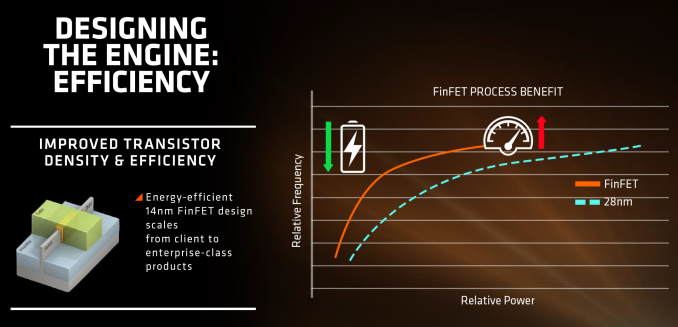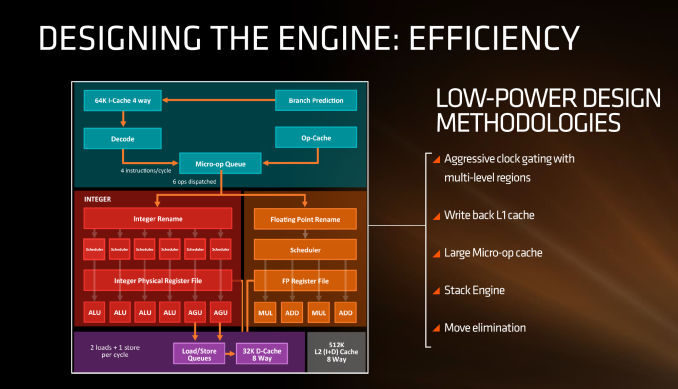AMD Zen Microarchitecture: Dual Schedulers, Micro-Op Cache and Memory Hierarchy Revealed
by Ian Cutress on August 18, 2016 9:00 AM ESTLow Power, FinFET and Clock Gating
When AMD launched Carrizo and Bristol Ridge for notebooks, one of the big stories was how AMD had implemented a number of techniques to improve power consumption and subsequently increase efficiency. A number of those lessons have come through with Zen, as well as a few new aspects in play due to the lithography.
First up is the FinFET effect. Regular readers of AnandTech and those that follow the industry will already be bored to death with FinFET, but the design allows for a lower power version of a transistor at a given frequency. Now of course everyone using FinFET can have a different implementation which gives specific power/performance characteristics, but Zen on the 14nm FinFET process at Global Foundries is already a known quantity with AMD’s Polaris GPUs which are built similarly. The combination of FinFET with the fact that AMD confirmed that they will be using the density-optimised version of 14nm FinFET (which will allow for smaller die sizes and more reasonable efficiency points) also contributes to a shift of either higher performance at the same power or the same performance at lower power.
AMD stated in the brief that power consumption and efficiency was constantly drilled into the engineers, and as explained in previous briefings, there ends up being a tradeoff between performance and efficiency about what can be done for a number of elements of the core (e.g. 1% performance might cost 2% efficiency). For Zen, the micro-op cache will save power by not having to go further out to get instruction data, improved prefetch and a couple of other features such as move elimination will also reduce the work, but AMD also states that cores will be aggressively clock gated to improve efficiency.
We saw with AMD’s 7th Gen APUs that power gating was also a target with that design, especially when remaining at the best efficiency point (given specific performance) is usually the best policy. The way the diagram above is laid out would seem to suggest that different parts of the core could independently be clock gated depending on use (e.g. decode vs FP ports), although we were not able to confirm if this is the case. It also relies on having very quick (1-2 cycle) clock gating implementations, and note that clock gating is different to power-gating, which is harder to implement.












216 Comments
View All Comments
patel21 - Friday, August 19, 2016 - link
Actually whom are you asking these questions ?Peichen - Friday, August 19, 2016 - link
Lets hope this isn't another one of AMD's empty claim that we've all seen like 8 times over the last 10 years on both CPU, GPU and the nonsense APU.The stock tripled over the last 12 months but that's only if Zen can deliver. If Zen is another <fill in AMD product for the last 10 years>, AMD will be a dollar stock again.
mxnerd - Friday, August 19, 2016 - link
Wow. AMD stock climbs 12.5% after the news.jihe - Friday, August 19, 2016 - link
I pray to god this is a worthwhile processorjust4U - Friday, August 19, 2016 - link
All it really needs to be is competitive on the performance front. It doesn't need to beat Intel but hey if it can well shoot.. that would be interesting. Not expecting that or even hoping for it since I think that would be unrealistic.cocochanel - Friday, August 19, 2016 - link
If Zen is good enough, it'll take some market share away from Intel, but not much since Intel CPU's are pretty much state of the art. However, the real advantages will come with their APU's (Zen + Polaris). The upcoming PlayStation Neo and Xbox Scorpio will use them. AMD will also go after mobile since they have no completion there with their APU's. Intel has some powerful iGPU's but they are nowhere near AMD APU's in performance. With the node disadvantage gone away, performance and power consumption should be up there. I know the desktop diehards will disagree, but desktops sales have been falling for years. Likely causes are a move by many to mobile devices and cheap, powerful gaming consoles. I don't see that trend changing. The ARM ecosystem is also rolling along and now it's beginning to creep into so far, exclusive x86 server markets. VR will also force ARM designers to come up with more powerful hardware. The next 5-10 years should be interesting.Michael Bay - Friday, August 19, 2016 - link
Problem is, mobile itself has reached saturation and isn`t so attractive anymore. Plus, what AMD is to go there with, x86? Intel tried already.Node disadvantage will come back at some point, simply because it`s a matter of survival for intel.
Where things should get interesting is the server side. ARM is hardly a threat, but AMD might have a good product here with GPU+CPU compute, likely at lower price.
cocochanel - Friday, August 19, 2016 - link
My mistake. By mobile, I meant laptops and not tablets. It's still a big market.Intel regaining node advantage ? Mmm, from I have seen in tech reports ( and I am not a big expert ), both 10nm and 7nm will be a tough nut to crack and will cost huge amounts. Compared to years past, Intel is now up against big giants ( Samsung and TSMC ) who are making billions every year selling tons of ARM SoC and have the deep pockets needed for new nodes. The South Koreans and the Chinese are a smart bunch. I mean, look at the SSD market. Intel had a lock on that until Samsung decided that one was too many. Remember Thunderbold ? Nice tech, but now the market is moving away from it. Sadly, even for mighty Intel, the landscape has changed.
I hope you're right about the server market. AMD can use any sales they can get, but then again, Intel has a lock on that and they will get aggressive and mean if necessary ( it's big bucks, you know).
ARM not a threat ? Architecturally speaking, they have advantages, after all, x86 is a dinosaur and ARM business model is one of their biggest strengths. But you're right, the installed base for x86 is huge and it will take time. There are some big names, however ( Qualcomm and others ) pouring some serious money in it.
Should be interesting.
Michael Bay - Saturday, August 20, 2016 - link
x86 is a very functional dinosaur with A LOT of companies standing behind it. ARM can license all they want, to actually break in and make those huge server monies, you need a full sw/hw/oem stack.I`d look at IBM`s last hooray POWER thing as the real competitor for intel right now, with AMD hopefully coming in soon as well.
BillBear - Saturday, August 20, 2016 - link
Google has announced their intention to open up competition in the server space by fully adopting IBM's POWER chips over their entire server software/hardware stack and is working with AMD and others to make sure they can do the same thing with the ARM based server chips in development.Competition is a good thing.